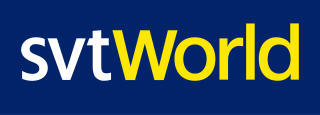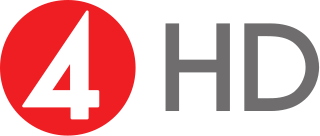
Sveriges Television AB, shortened to SVT, is the Swedish national public television broadcaster, funded by a public service tax on personal income set by the Riksdag. Prior to 2019, SVT was funded by a television licence fee payable by all owners of television sets. The Swedish public broadcasting system is largely modelled after the system used in the United Kingdom, and Sveriges Television shares many traits with its British counterpart, the BBC.

SVT1 is the primary television station of the Swedish public service broadcaster Sveriges Television in Sweden.

SVT2, is one of the two main television channels broadcast by Sveriges Television in Sweden.
Canal Digital was a Nordic pay TV and internet service provider in Norway, Sweden, Denmark and Finland that was founded in March 1997 as a joint venture between the French pay TV company Canal+ and the Norwegian telecommunications operator Telenor.

SVT24, stylized as svt24, formerly known as SVT 24 or 24 is a Swedish language TV channel broadcast by Sveriges Television (SVT). It started broadcasting in 1999 as a dedicated news channel. In 2003 it extended its scope to include other current events-related programmes and sports at the weekend. Nowadays the channel mainly consists of news, sports, and entertainment programmes with a focus on reruns from SVT1 and SVT2.

SVT World was an international television channel from the Swedish broadcaster Sveriges Television. The channel was available on satellite in Europe and much of Africa, Australia and Asia, terrestrially in parts of Finland and worldwide via IPTV.

CCTV-1 is the primary channel of CCTV, the national flagship terrestrial television network of the People's Republic of China. It broadcasts a range of programs from CCTV Headquarters at East 3rd Ring Road in Beijing and is available to both cable and terrestrial television viewers. The terrestrial signal of CCTV-1 is free-to-air across China. However, due to copyright restrictions, the satellite signal of CCTV-1 is encrypted, and smartcards are necessary for decryption.
Digital terrestrial television in Australia commenced on 1 January 2001 in Sydney, Melbourne, Brisbane, Adelaide and Perth using DVB-T standards. The phase out of analogue PAL transmissions began on 30 June 2010 and was completed by 10 December 2013.
BBC HD was a high-definition television channel owned by the BBC. The channel was initially run as a trial from 15 May 2006 until becoming a full service on 1 December 2007 before its discontinuation on 25 March 2013. It broadcast only during the afternoon and evening and only broadcast material shot in high definition, either in a simulcast with another channel or by inserting a repeat of an HD programme.
ITV1 HD is a British free-to-air high-definition public broadcast television network operated by ITV plc, the company which is contracted to provide 13 ITV1 services across the UK. ITV1 HD simulcasts them in high-definition. ITV1 HD is available to view in England, Wales, Scottish Borders and the Channel Islands on Freesat via channel 103, Freeview channel 103, Sky channel 103, Virgin Media channel 103 and in Switzerland on SwisscomTV.

TV4 HD is a Swedish high-definition television channel from TV4 AB.
Digital terrestrial television was launched in Sweden in 1999. The shutdown of the analogue equivalent started on September 19, 2005, and was finalized on October 15, 2007.
There are four major forms of digital television (DTV) broadcast in the United Kingdom: a direct-to-home satellite service from the Astra 28.2°E satellites provided by Sky UK, a cable television service provided by Virgin Media ; a free-to-air satellite service called Freesat; and a free-to-air digital terrestrial service called Freeview. In addition, an IPTV system known as EE TV is provided by EE. Individual access methods vary throughout the country. 77% of the United Kingdom has access to HDTV via terrestrial digital television. Satellite is the only source of HDTV broadcast available for the remaining 23%.
High-definition television in the United Kingdom is available via cable, IPTV, satellite and terrestrial television. The first high-definition broadcasts began in late 2005 and since then the number of channels available to view has grown to a maximum of 87 that can be viewed on pay-TV service, Sky.
Television began in Sweden in 1954 with test transmissions, prior to the opening of the first station, Radiotjänst, two years later. A second channel was launched in 1969. Commercial television arrived in the 1980s through cable television and in 1992, the country's first terrestrial commercial channel was launched.
The Netherlands now has three major forms of broadcast digital television. Terrestrial (DVB-T), Cable (DVB-C), and Satellite (DVB-S). In addition IPTV services are available. At the end of the first quarter of 2013 almost 84% of the households in the Netherlands had some form of digital television.
The transition to high-definition television is a process by which standard-definition (SD) television signals are upgraded to a high-definition (HD) format. In this process, channels usually either simulcast their HD signals alongside the existing SD signals or broadcast exclusively in HD. The transition to the latter is often called the standard-definition television switch-off.









